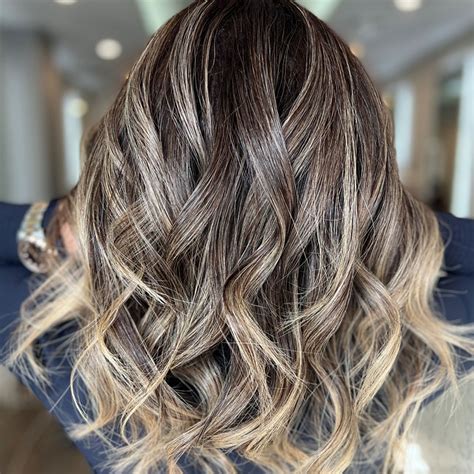In the realm of hair coloring, the battle between balayage and highlights has been raging for years, each technique promising unique results and catering to distinct preferences. Whether you’re a hair virtuoso or simply curious about the latest hair coloring trends, this comprehensive guide will dissect the intricacies of both balayage and highlights, arming you with the knowledge to make an informed decision before your next salon visit.

Balayage: A Graceful Sweep of Color
Balayage, a French term meaning “to sweep,” is a freehand hair coloring technique that creates a natural, sun-kissed effect. The colorist meticulously “sweeps” the dye onto the hair, blending it seamlessly from dark roots to lighter ends. This technique mimics the gradual lightening that occurs naturally from prolonged sun exposure.
Pros of Balayage:
- Natural and gradual: Blends seamlessly with existing hair color, creating a soft and dimensional look.
- Low maintenance: Requires less frequent touch-ups compared to highlights due to the gradual transition from dark to light.
- Versatile: Can be tailored to your desired level of lightness, from subtle highlights to dramatic blonde.
- Less damaging: Uses a more gentle approach to coloring, minimizing damage to hair compared to traditional highlighting.
Cons of Balayage:
- Time-consuming: Can take several hours to complete, especially for longer hair.
- Pricey: Generally more expensive than traditional highlights due to the labor-intensive nature of the technique.
- Skill-dependent: Requires a skilled colorist with experience in balayage to achieve the desired results.
Highlights: Defined and Contrasting
Highlights, also known as foils, are a more traditional hair coloring technique that involves using small sections of aluminum foil to isolate and bleach strands of hair. This creates a more defined and contrasting effect dibandingkan dengan balayage. The result is a vibrant, eye-catching look that can add depth and dimension to your hair.
Pros of Highlights:
- Bold and striking: Creates a more noticeable and dramatic change in hair color.
- Versatile: Can be placed in specific areas to enhance facial features or add volume.
- Precision: Foils allow for precise placement of color, ensuring a consistent and even result.
- Affordable: Generally less expensive than balayage, especially for short hair.
Cons of Highlights:
- High maintenance: Requires regular touch-ups to maintain the desired level of contrast, which can be damaging to hair over time.
- Can look artificial: If not done skillfully, highlights can appear too bold or unnatural.
- Limited blending: The foil isolation prevents the gradual transition of color seen in balayage.
Choosing Between Balayage and Highlights: A Decision Tree
Deciding between balayage and highlights ultimately depends on your individual preferences, hair type, and desired outcome. Here’s a simple decision tree to help you navigate your choice:
- Do you prefer a natural, sun-kissed look or a bold and contrasting effect?
- If you favor a natural look, balayage is a better option.
-
If you desire a more dramatic change, highlights are the way to go.
-
How much maintenance are you willing to commit to?
- If you prefer less upkeep, balayage is the better choice due to its gradual transition of color.
-
If you’re willing to invest time and effort in maintenance, highlights offer more vibrant and defined results.
-
What is your hair type?
- Balayage is more suitable for all hair types, including fine or damaged hair.
- Highlights can be more damaging to fine or brittle hair.
Common Mistakes to Avoid When Coloring Hair
To achieve the best results from either balayage or highlights, it’s crucial to avoid common mistakes that can compromise the health and appearance of your hair.
- Over-lightening: Avoid over-bleaching your hair, which can lead to breakage, dullness, and a brassy tone.
- Uneven application: Ensure that the color is applied evenly throughout your hair to prevent patches or streaks.
- Overlapping foils: When using foils for highlights, avoid overlapping them, as this can cause over-processing and damage.
- Poor quality products: Use high-quality hair coloring products designed for your hair type to minimize damage and achieve optimal results.
- Inadequate aftercare: Follow your colorist’s instructions for aftercare, including using color-safe shampoos and conditioners, to maintain the vibrancy and longevity of your hair color.
Innovative Applications of Balayage and Highlights
While balayage and highlights are traditional techniques, creative applications can create fresh and innovative looks.
- Sombré: A subtle variation of balayage where the color transition is even more gradual, creating an almost ombre-like effect.
- Babylights: Superfine highlights placed throughout the hair, giving the illusion of natural sun-kissed hair.
- Ribbon highlighting: Wide, contrasting highlights placed in sections to create a bold and striking look.
- Ecaille: A tortoiseshell-inspired technique where multiple shades of balayage are applied to create a multidimensional and complex look.
Key Statistics and Market Insights
- According to Allied Market Research, the global hair color market was valued at $32.7 billion in 2020 and is projected to reach $60.6 billion by 2030, growing at a CAGR of 6.4%.
- A survey by the Professional Beauty Association (PBA) found that 85% of hair color clients prefer a natural-looking finish, with balayage being the most requested technique.
- Statistics from the American Hair Loss Association indicate that over 50% of women experience some degree of hair loss in their lifetime, making hair coloring techniques like balayage and highlights an attractive option for adding volume and the illusion of fuller hair.
Conclusion
The choice between balayage and highlights is a matter of personal preference, hair type, and desired outcome. Balayage offers a natural, sun-kissed look with low maintenance, while highlights provide a more bold and contrasting effect. By understanding the pros and cons of each technique, you can make an informed decision and achieve the perfect hair color for your unique style and needs.
